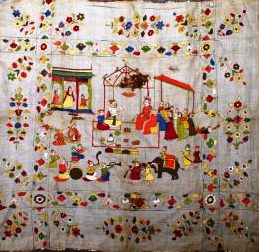
Art history/ Historiography, Crafts, Handlooms, Art
Forests in Traditional Art Forms
Jaitly, Jaya
September, 2018
Forests, jungles, groves, trees and plants have been sacred for large sections of humanity. First, in many animist religions and, later, when ritualistic religions invested them with greater significance. Yuval Noah Harari’s book, Sapiens, tells us how, through a quirk in the wiring in their brains, humans developed a crucial feature that differentiated them from other creatures. This was the ability to create ideas, concepts, myths and systems of functioning, weaving together whatever the imagination could conjure. Humans became aware of their ability to create imagined ideas to bolster facts each needed to know for their survival amongst other creatures, which they communicated through words, symbols or images. Harari writes, “Legends, myths, gods and religions appeared for the first time with the Cognitive Revolution. Many animals and human species could previously say, ‘Careful! A lion!’ Thanks to the Cognitive Revolution, Homo sapiens acquired the ability to say, ‘The lion is the guardian spirit of our tribe.’” This ability to create fictions is the most unique feature of human language.
As forest dwellers, hunters and gatherers roamed the earth, they learned of the value or dangers that lay within the swathes of dense forests that covered the planet, and the large and small creatures that dwelled within them. They also began to discover the nutritional and medicinal benefits of plants and trees. The concept of “sacredness” would have developed as a fictional rationale to protect and preserve those plants and trees for their own benefit. The wor...
This is a preview. To access all the essays on the Global InCH Journal a modest subscription cost is being levied to cover costs of hosting, editing, peer reviewing etc. To subscribe, Click Here.



